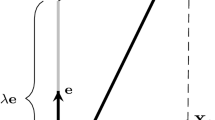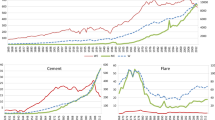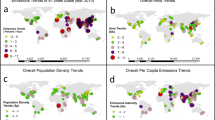Abstract
In a spatial property modeling context, the variables of interest to be modeled often display complex nonlinear features. Techniques to incorporate these nonlinear features, such as multiple point statistics or cummulants, are often complex with input parameters that are difficult to infer. The methodology proposed in this paper uses a classical vector-based definition of locally varying anisotropy to characterize nonlinear features and incorporate locally varying anisotropy into numerical property models. The required input is an exhaustive field of anisotropy orientation and magnitude. The methodology consists of (1) using the shortest path distance between locations to define the covariance between points in space (2) multidimensional scaling of the domain to ensure positive definite kriging equations and (3) estimation or simulation with kriging or sequential Gaussian simulation. The only additional parameter required when kriging or simulating with locally varying anisotropy is the number of dimensions to retain in multidimensional scaling. The methodology is demonstrated on a CO2 emissions data set for the United States in 2002 and shows an improvement in cross validation results as well as a visual reproduction of nonlinear features.









Similar content being viewed by others
References
Boisvert J (2010) Geostatistics with Locally Varying Anisotropy. Dissertation, University of Alberta
Boisvert J, Deutsch C (2011) Programs for kriging and sequential Gaussian simulation with locally varying anisotropy using non-Euclidean distances. Comput Geosci 37(4):495–510
Cressie N, Majure J (1997) Spatio-temporal statistical modeling of livestock waste in streams. J Agric Biol Environ Stat 2:24–47
Curriero F (2005) On the use of non-Euclidean distance measures in geostatistics. Math Geol 38:907–926
Deutsch CV, Journel A (1998) GSLIB: Geostatistical software library and user’s guide. Oxford University Press, New York
Dijkstra E (1959) A note on two problems in connection with graphs. Numerische Mathematik 1:269–271
Gurney K (2010) Vulcan Project. http://www.purdue.edu/eas/carbon/vulcan/index.php. Accessed March 2010
Gurney K, Mendoza D, Zhou Y, Fischer M, Miller C, Geethakumar S, De La Rue Du Can S (2009) High resolution fossil fuel combustion CO2 emission fluxes for the United States. Environ Sci Technol 43:5535–5541
Hassanpour R (2007) Tools for multivariate modeling of permeability tensors and geometric parameters for unstructured grids. Dissertation, University of Alberta
Izenman A (2008) Modern multivariate statistical techniques: regression, classification and manifold learning. Springer, New York
Little L, Edwards D, Porter E (1997) Kriging in estuaries: as the crow flies, or as the fish swims? J Exp Mar Biol Ecol 213:1–11
Loland A, Host G (2003) Spatial covariance modelling in a complex costal domain by multidimensional scaling. Environmetrics 14:307–321
Peyre G (2008) Toolbox fast marching—a toolbox for Fast Marching and level sets computations. http://www.mathworks.com/matlabcentral/fileexchange/6110. Accessed April 2010
Rathbun S (1998) Spatial modeling in irregularly shaped regions: kriging estuaries. Environmetrics 9:109–129
Sampson P, Guttorp P (1992) Nonparametric estimation of nonstationary spatial covariance structure. J Am Stat Assoc 87:108–119
Sethian JA (1999) Level set methods and fast marching methods: evolving interfaces in computational geometry fluid mechanics computer vision and materials science. Cambridge University Press, New York
Siek J, Lee L, Lumsdaine A (2001) The boost graph library: user guide and reference manual. Addison Wesley, Boston
Tenenbaum J, Silva V, Langford J (2000) A global geometric framework for nonlinear dimensionality reduction. Science 290:2319–2323
ver Hoef J, Peterson E, Theobald D (2006) Spatial statistical models that use flow and stream distance. Environ Ecol Stat 13:449–464
Author information
Authors and Affiliations
Corresponding author
Rights and permissions
About this article
Cite this article
Boisvert, J.B., Deutsch, C.V. Modeling locally varying anisotropy of CO2 emissions in the United States. Stoch Environ Res Risk Assess 25, 1077–1084 (2011). https://doi.org/10.1007/s00477-011-0483-7
Published:
Issue Date:
DOI: https://doi.org/10.1007/s00477-011-0483-7




